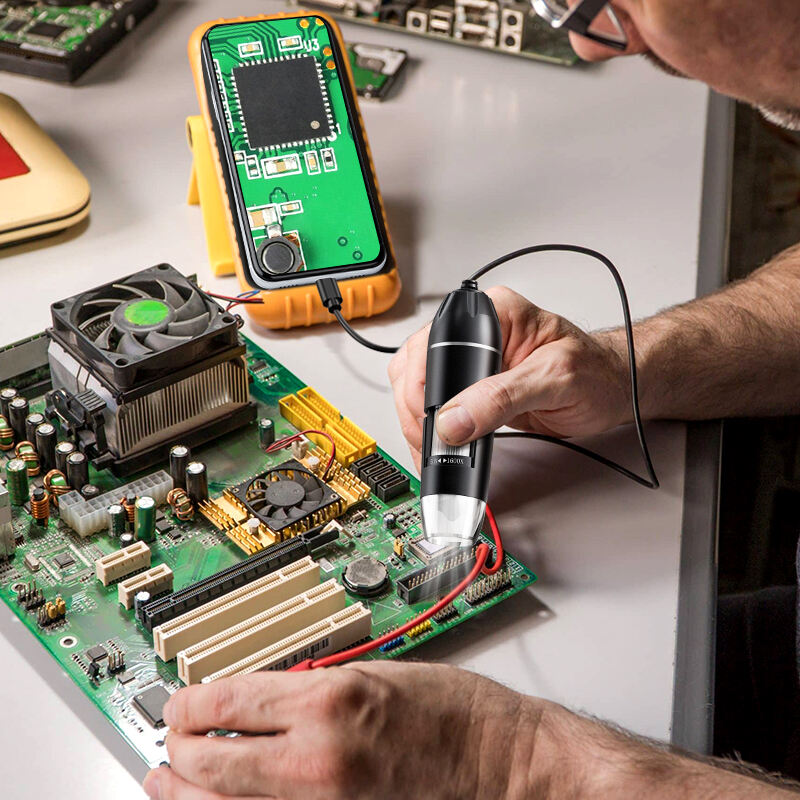In today's digital age, scientific exploration has become more accessible than ever, especially with the emergence of affordable phone microscope attachments and handheld devices. These innovative tools transform your smartphone into a powerful magnification instrument, opening up microscopic worlds without breaking the bank. Whether you're a student, educator, hobbyist, or parent looking to spark curiosity in children, finding the right phone microscope under fifty dollars can provide exceptional value and educational opportunities.

The market offers numerous budget-friendly options that deliver impressive magnification capabilities while maintaining portability and ease of use. From simple clip-on lenses to sophisticated handheld units with built-in screens, these devices cater to various needs and skill levels. Understanding the features, limitations, and applications of different models helps consumers make informed decisions that align with their specific requirements and budget constraints.
Understanding Phone Microscope Technology
Basic Operating Principles
Modern phone microscope systems utilize advanced optical engineering to achieve significant magnification levels through compact designs. The fundamental principle involves positioning specialized lenses in precise alignment with smartphone cameras to enhance their natural zoom capabilities. These systems typically incorporate multiple lens elements, including objective lenses, eyepieces, and sometimes intermediate magnifying components that work together to produce clear, detailed images of microscopic specimens.
The integration between hardware and smartphone software creates seamless user experiences, allowing real-time viewing, image capture, and video recording of magnified subjects. Quality phone microscope units maintain optical clarity while minimizing distortion, chromatic aberration, and other common issues that can degrade image quality. Understanding these technical aspects helps users appreciate the engineering sophistication packed into these affordable devices.
Magnification Capabilities and Limitations
Budget phone microscope models typically offer magnification ranges between 60x and 1000x, though actual effective magnification depends on various factors including lens quality, smartphone camera specifications, and viewing conditions. Higher magnification levels don't always translate to better image quality, as factors like illumination, stability, and optical precision become increasingly critical at greater zoom levels.
Users should understand that advertised magnification numbers represent theoretical maximum capabilities under ideal conditions. Practical magnification levels often provide better image quality and easier specimen observation, making mid-range zoom settings more useful for most applications. The key lies in finding devices that balance magnification power with optical clarity and user-friendly operation.
Essential Features for Budget Models
Illumination Systems
Proper lighting represents one of the most crucial factors determining image quality in microscopy applications. Budget phone microscope units typically incorporate LED illumination systems that provide consistent, bright lighting for specimen observation. The number, positioning, and quality of LEDs directly impact the clarity and detail visible in magnified images, making illumination a priority consideration when selecting affordable models.
Advanced budget models feature adjustable LED brightness controls, allowing users to optimize lighting conditions for different specimen types and magnification levels. Some units include both transmitted and reflected lighting options, expanding their versatility for observing various sample types. Quality illumination systems also incorporate diffusion elements to ensure even light distribution and minimize harsh shadows or hotspots that can obscure important details.
Build Quality and Durability
Despite their affordable pricing, reliable phone microscope units maintain robust construction that withstands regular use and occasional mishandling. Quality budget models utilize durable plastic housings, reinforced lens mounts, and secure attachment mechanisms that protect delicate optical components while ensuring stable operation. The balance between cost-effectiveness and durability determines the long-term value proposition of these devices.
Attention to detail in manufacturing processes affects everything from lens alignment to control responsiveness, directly impacting user experience and image quality. Reputable manufacturers implement quality control measures that ensure consistent performance across production batches, while inferior products may exhibit significant variation in optical quality and mechanical reliability. Investing in well-constructed budget models provides better long-term satisfaction and educational value.
Top Budget Phone Microscope Categories
Clip-On Smartphone Attachments
Clip-on phone microscope attachments represent the most affordable entry point into smartphone microscopy, typically priced well under fifty dollars while offering decent magnification capabilities. These compact devices attach directly to smartphone cameras through spring-loaded clips or magnetic mounts, transforming phones into portable microscopes within seconds. Their simplicity makes them ideal for casual users, students, and anyone seeking convenient magnification without complex setup procedures.
The best clip-on models feature high-quality glass lenses, adjustable focus mechanisms, and integrated LED lighting systems that enhance their functionality beyond basic magnification. While they may lack the advanced features of standalone units, quality clip-on attachments provide excellent value for users who prioritize portability and simplicity over maximum magnification power or specialized capabilities.
Handheld Digital Microscopes
Handheld digital microscopes with built-in screens offer greater independence from smartphones while maintaining budget-friendly pricing structures. These self-contained units incorporate their own optical systems, digital sensors, LED illumination, and LCD displays, creating complete microscopy solutions that don't require additional devices. Their standalone nature makes them particularly suitable for field work, classroom demonstrations, and situations where smartphone availability might be limited.
Modern handheld units often include features like image capture, video recording, measurement tools, and connectivity options that enhance their educational and professional applications. The phone microscope technology in these devices continues advancing rapidly, with newer models offering improved image quality, longer battery life, and more intuitive user interfaces while maintaining affordable pricing points.
Key Selection Criteria
Optical Quality Assessment
Evaluating optical quality in budget phone microscope models requires understanding several critical factors that determine image clarity and detail resolution. Lens quality represents the foundation of optical performance, with better models utilizing multi-element glass lenses that minimize distortion and chromatic aberration. The precision of lens manufacturing and assembly directly affects image sharpness, color accuracy, and overall viewing experience across different magnification levels.
Resolution capabilities depend not only on magnification power but also on the quality of optical components and their integration with digital imaging systems. Users should prioritize devices that maintain image clarity throughout their magnification range rather than focusing solely on maximum zoom capabilities. Testing samples under various lighting conditions and magnification levels provides the most accurate assessment of optical performance.
Compatibility and Connectivity
Modern phone microscope units must accommodate diverse smartphone models and operating systems while maintaining secure attachment and optimal alignment. The best budget models feature universal mounting systems that work reliably across different phone sizes and camera configurations. Adjustability in positioning and alignment ensures proper optical alignment regardless of specific smartphone specifications.
Connectivity features like WiFi capability, USB connections, and app integration expand the functionality of budget microscope units beyond basic magnification. These features enable image sharing, remote viewing, measurement capabilities, and integration with educational software platforms. While not essential for basic applications, connectivity options significantly enhance the educational and professional utility of affordable microscope systems.
Practical Applications and Use Cases
Educational Applications
Budget phone microscope units excel in educational environments where cost-effectiveness and ease of use take priority over advanced research capabilities. Teachers can utilize these devices to demonstrate cellular structures, crystal formations, textile fibers, and countless other microscopic phenomena that enhance science curricula. The ability to project magnified images onto classroom screens or capture them for later analysis transforms traditional microscopy lessons into engaging, interactive experiences.
Students benefit from hands-on experience with accessible microscopy tools that encourage independent exploration and scientific curiosity. The affordability of these devices enables schools to provide individual or small-group access rather than limiting students to shared, expensive traditional microscopes. This democratization of microscopy technology supports more inclusive and comprehensive science education approaches.
Hobby and Professional Applications
Hobbyists across numerous disciplines find value in affordable phone microscope systems for examining collectibles, analyzing materials, inspecting craftsmanship details, and exploring natural specimens. Coin collectors use these devices to assess condition and authenticity, while jewelry enthusiasts examine gemstone characteristics and metalwork details. The portability of budget units makes them ideal for field research, outdoor exploration, and travel applications where traditional microscopes would be impractical.
Professional applications include quality control inspections, preliminary material analysis, and documentation tasks where high-end equipment might be unnecessary or unavailable. Technicians use portable microscopes for circuit board inspection, surface analysis, and component examination in field service situations. While these applications don't require research-grade precision, they benefit significantly from the convenience and accessibility of modern budget microscope technology.
Maintenance and Care Guidelines
Proper Storage and Handling
Maintaining budget phone microscope units requires attention to proper storage practices that protect delicate optical components from damage and contamination. Lens surfaces represent the most vulnerable elements, requiring protection from dust, fingerprints, moisture, and physical impact. Quality storage cases or protective covers help preserve optical clarity and extend device lifespan, making them worthwhile investments for regular users.
Handling procedures should minimize stress on mounting mechanisms, lens assemblies, and electronic components while ensuring secure connections during use. Avoiding extreme temperatures, excessive humidity, and mechanical shock helps preserve both optical and electronic functionality over extended periods. Regular inspection of mounting hardware and electrical connections prevents minor issues from developing into major problems.
Cleaning and Calibration
Regular cleaning maintains optimal image quality and prevents contamination from degrading optical performance over time. Lens cleaning requires appropriate materials and techniques that remove debris without scratching or damaging delicate optical surfaces. Microfiber cloths, lens cleaning solutions, and compressed air provide safe, effective cleaning methods when used properly and consistently.
Calibration procedures ensure accurate magnification measurements and optimal focus performance across the device's operational range. While budget units may lack sophisticated calibration features, users can establish reference standards and maintain consistent setup procedures that optimize performance. Understanding the limitations and capabilities of specific devices helps users achieve the best possible results within their equipment's constraints.
FAQ
What magnification level works best for general use with budget phone microscope units?
For most general applications, magnification levels between 100x and 400x provide the optimal balance of image quality, ease of use, and practical utility. These ranges allow clear observation of cellular structures, crystal formations, fabric details, and small mechanical components while maintaining manageable focus requirements and adequate illumination. Higher magnifications often require more precise setup and specialized techniques that can be challenging for casual users.
Can budget phone microscope attachments work effectively with all smartphone models?
Most quality budget phone microscope units feature universal mounting systems designed to accommodate various smartphone sizes and camera configurations. However, optimal performance depends on proper alignment between the microscope lens and smartphone camera, which may require adjustment for different devices. Users should verify compatibility with their specific phone model and camera placement before purchasing, as some designs work better with certain smartphone configurations than others.
How important is LED lighting quality in affordable phone microscope systems?
LED lighting quality significantly impacts image clarity and detail visibility, often determining the practical usability of budget microscope units. Quality illumination systems provide even, bright lighting that reveals specimen details without creating harsh shadows or hotspots. Adjustable brightness controls and multiple LED configurations enhance versatility for different specimen types and magnification levels, making illumination one of the most important factors to consider when selecting affordable models.
What maintenance requirements should users expect with budget phone microscope devices?
Budget phone microscope units require minimal maintenance when handled properly, primarily involving regular lens cleaning and careful storage practices. Users should clean optical surfaces with appropriate materials, protect devices from dust and moisture, and inspect mounting mechanisms periodically for wear or damage. Avoiding extreme temperatures and mechanical stress helps preserve both optical and electronic components, while proper storage extends overall device lifespan and maintains performance quality.
Table of Contents
- Understanding Phone Microscope Technology
- Essential Features for Budget Models
- Top Budget Phone Microscope Categories
- Key Selection Criteria
- Practical Applications and Use Cases
- Maintenance and Care Guidelines
-
FAQ
- What magnification level works best for general use with budget phone microscope units?
- Can budget phone microscope attachments work effectively with all smartphone models?
- How important is LED lighting quality in affordable phone microscope systems?
- What maintenance requirements should users expect with budget phone microscope devices?

